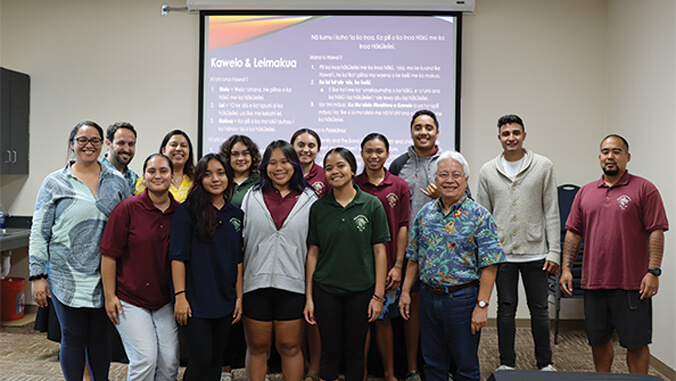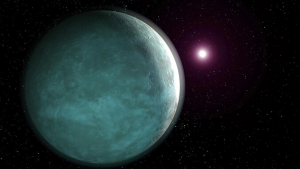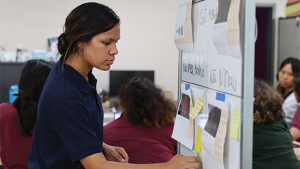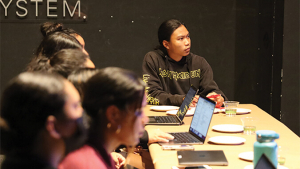
A planet-and-star pair located more than 400 light years away could become the next celestial objects bearing inoa (names) in ʻōlelo Hawaiʻi or the Hawaiian language. A Hua He Inoa, a program out of ʻImiloa Astronomy Center of Hawaiʻi at the University of Hawaiʻi at Hilo that provides Hawaiian names to astronomical discoveries, recently mentored 10 high school interns from the Hawaiian language immersion charter school Ke Kula ʻo Nāwahīokalaniʻōpuʻu to propose the names for the Neptune-mass gas giant planet and its star as part of the global 2022 NameExoWorlds competition. The proposed names Leimakua and Kawelo were chosen to honor ancestral knowledge and the familial bond between the planet and star.
“Nui ka haʻaheo! We are incredibly proud of these students who brought forth their own knowledge and wisdom to this process,” said Kaʻiu Kimura, executive director at ʻImiloa. “Their contributions will deepen our Hawaiʻi relationships to astronomical discovery as the story of all of our connections to the universe unfolds.”

The proposed inoa (names) were identified by looking at the metaphorical relationship between planet (HAT-P-26 b) and star (HAT-P-26) as being one between a parent and its child. The exoplanet detected in 2010 with the help of the Submillimeter Array and W. M. Keck Observatory on Maunakea, closely orbits its host star every 4.2 days.
“Every time I look up at the stars, I always get excited and I wonder what’s out there,” said Kaʻimi Galima-Elvena, a Hua He Inoa student intern. “And, to be able to connect that to my culture, is very important because, to me, this is not about one single person. This is about all of us as a community and how we live in Hawaiʻi.”
In ʻōlelo Hawaiʻi, makua means parent or parental relationship. The haumāna (students) chose Leimakua for the planet since its close orbit reminded them of a lei around the star and because a lei can also symbolize the bond between them.
“There is a poetic saying in Hawaiian where lei or necklaces symbolize children and that the makua or parent never casts aside this lei because of this connection between parent and child,” said Galima-Elvena.

For the proposed name of the star, haumāna also looked to the epic tale, Ka Moʻolelo Hiwahiwa o Kawelo. In a portion of the story, a boy named Kawelo gathers water in his ʻumeke (calabash or gourd), which symbolizes the knowledge that is being perpetuated. The word welo also means to float in a stream, or flutter in the wind, and symbolically represents a continuation or lineal legacy.
“When you fill that ʻumeke of water, you are building up the life of your community,” said Kahaukepa ʻAipia-Peters, a A Hua He Inoa student intern. “So that if we bring up the name of the moʻolelo, which is Kawelo Leimakua, in this ʻumeke of knowledge, then we will continue on this knowledge and honor the knowledge of our ancestors.”
The International Astronomical Union, the recognized global authority for naming objects in space, will decide on winning submissions for this ExoWorld Naming competition they are hosting by spring 2023. If the names are accepted, they will join a list of six astronomical discoveries given ʻōlelo Hawaiʻi names by Hawaiian language speakers as part of ʻImiloa’s integral program.

- Leleakūhonua, dwarf planet UH News, November 16, 2020
- Pōniuāʻena, the most massive quasar known in the early universe UH News, June 25, 2020
- Pōwehi, world’s first-imaged black hole UH News, April 10, 2019
- Kamoʻoalewa and Kaʻepaokaʻāwela, two asteroids UH News, January 8, 2019
- ʻOumuamua, interstellar object UH News, November 20, 2017
Haumāna were assisted by ʻImiloa staff, Kumu (teacher) Larry Kimura, an associate professor at UH Hilo Ka Haka ʻUla O Keʻelikōlani College of Hawaiian Language, representatives from Maunakea Observatories and Ke Kula ʻo Nāwahīokalaniʻōpuʻu.

